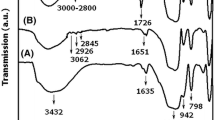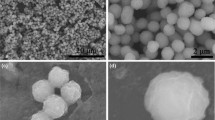Abstract
Two new highly luminescent Tb(III) coordination complexes of β-diketone ligands, [TbLІ(NO3)3(H2O)] 1 [LІ=N-(2-pyridinyl)ketoacetamide] and [TbLІІ 2(NO3)2(C3H6O)][TbLІІ(NO3)4] 2 [LІІ=N-(6-(4-methylpyridinyl))ketoacetamide], were synthesized and characterized by single crystal X-ray diffraction, and incorporated into SiO2/polymer hybrid material by sol–gel method resulting in a novel ternary molecular hybrid material. The Tb(III) complexes display characteristic metal-centered luminescence while the ligands emission are completely quenched, showing that efficient ligand-to-metal energy transfer (antenna effect) occurs. The gels can exhibit the characteristic emission bands of terbium ion. In addition, terbium ions present longer fluorescence lifetime in gels than in the corresponding pure complexes powders. Compared with the complexes, the unit mass luminescence intensities of the gels are enhanced. And the increase extent of luminescence intensity of the gel is influenced by the substituent of the ligands. At the same time, concentration effects on the luminescence intensity were investigated. The photo stabilities of the gels under UV radiation are much better than those of the pure terbium complexes.









Similar content being viewed by others
References
Weissman SI (1942) Intramolecular energy transfer the fluorescence of complexes of europium. J Chem Phys 10(4):214–217
Forsberg JH (1981) Gmelin handbook of inorganic chemistry, Sc, Y, La-Lu rare earth elements, 3rd edn. Springer, Berlin, pp 65–251 (and references therein)
Melby LR, Rose NJ, Abramson E, Caris JC (1964) Synthesis and fluorescence of some trivalent lanthanide complexes. J Am Chem Soc 86(23):5117–5125
Drake SR, Lyons A, Otway DJ, Slwain AMZ, Williams DJ (1993) Lanthanide b-diketonate glyme complexes exhibiting unusual co-ordination modes. J Chem Soc, Dalton Trans 15:2379–2386
Wang CY, Yang ZJ, Li Y, Gong LW, Zhao GW (2002) Preparation of thin films of ternary complex of europium with 2-thenoyltrifluoroacetone and o-phenanthroline. Phys Status Solid A 191(1):117–124
Zhong GL, Kim K, Jin JI (2002) Intermolecular energy transfer in photo- and electroluminescence properties of a europium(III) complex dispersed in poly(vinylcarbazole). Synth Met 129(2):193–198
Adachi C, Baldo MA, Forrest SR (2000) Electroluminescence mechanisms in organic light emitting devices employing a europium chelate doped in a wide energy gap bipolar conducting host. J Appl Phys 87(11):8049–8055
Sano T, Fujita M, Fujii T, Hamada Y, Shibata K, Kuroki K (1995) Novel europium complex for electroluminescent devices with sharp red emission. Jpn J Appl Phys 34(4A):1883–1887
Li HH, Inoue S, Machida K, Adachi G (1999) Preparation and luminescence properties of organically modified silicate composite phosphors doped with an europium(III) b-diketonate complex. Chem Mater 11(11):3171–3176
Samelson H, Lempicki A, Brophy VA, Brecher C (1964) Laser phenomena in europium chelates. I. Spectroscopic properties of europium benzoylacetonate. J Chem Phys 40(9):2547–2553
Bjorklund S, Kellermeyer G, Hurt CR, McAoy N, Filipescu N (1967) Laser action from terbium trifluoroacetylacetonate in p-dioxane and acetonitrile at room temperature. Appl Phys Lett 10(5):160–162
Whittakker B (1970) Low threshold laser action of a rare earth chelate in liquid and solid host media. Nature 228:157–159
Dawson WR, Kropp JL, Windsor MW (1966) Internal-energy-transfer efficiencies in Eu3 + and Tb3+chelates using excitation to selected ion levels. J Chem Phys 45(7):2410–2418
Crosby GA, Whan RE, Alire RM (1961) Intramolecular energy transfer in rare earth chelates. role of the triplet state. J Chem Phys 34(3):743–748
Filipescu N, Sager WF, Serafin FA (1964) Substituent effects on intramolecular energy transfer. II. Fluorescence spectra of eeuropium and terbium β-diketone chelates. J Phys Chem 68(11):3324–3346
de Sá GF, Malta OL, de Mello Donegá C, Simas AM, Longo RL, Santa-Cruz PA, da Silva EF (2000) Spectroscopic properties and design of highly luminescent lanthanide coordination complexes. Coord Chem Rev 196(1):165–195
Dong DW, Jiang SC, Men YF, Ji XL, Jiang BZ (2000) Nanostructured hybrid organic–inorganic lanthanide complex films produced in situ via a sol-gel approach. Adv Mater 12(9):646–649
Binnemans K, Lenaerts P, Driesen K, Görller-Walrand C (2004) A luminescent tris(2-thenoyltrifluoroacetonato)europium(III) complex covalently linked to a 1,10-phenanthroline-functionalised sol–gel glass. J Mater Chem 14(2):191–195
Sanchez C, Lebeau B (2001) Design and properties of hybrid organic–inorganic nanocomposites for photonics. Mater Res Soc Bull 26:377–387
Matthews LR, Knobbe ET (1993) Luminescence behavior of europium complexes in sol–gel derived host materials. Chem Mater 5(12):1697–1700
Franville AC, Zambon D, Mahiou R, Troin Y (2000) Luminescence behavior of sol–gel-derived hybrid materials resulting from covalent grafting of a chromophore unit to different organically modified alkoxysilanes. Chem Mater 12(2):428–435
Bredol M, Jüstel T, Gutzov S (2001) Luminescence of sol–gel-derived silica doped with terbium-benzoate complex. Opt Mater 18(3):337–341
Qian GD, Wang MQ, Wang M, Fan XP, Hong ZL (1997) Synthesis in situ of 2,2¢-dipyridyl-Tb(III) complexes in silica gel. J Mater Sci Lett 16(4):322–323
Fu LS, Meng QG, Zhang HJ, Wang SB, Yang KY, Ni JZ (2000) In situ synthesis of terbium-benzoic acid complex in sol–gel derived silica by a two-step sol–gel method. J Phys Chem Solids 61(11):1877–1881
Rosa ILV, Serra OA, Nassar EJ (1997) Luminescence study of the [Eu(bpy)2]3+ supported on Y zeolite. J Lumin 72–74:532–534
Xu QH, Fu LS, Li LS, Zhang HJ, Xu RR (2000) Preparation, characterization and photophysical properties of layered zirconium bis(monohydrogenphosphate) intercalated with rare earth complexes. J Mater Chem 10(11):2532–2536
Xu QH, Li LS, Liu XS, Xu RR (2002) Incorporation of rare-earth complex Eu(TTA)4C5H5NC16H33 into surface-modified Si-MCM-41 and its photophysical properties. Chem Mater 14(2):549–555
Zhang MS, Yin W, Su Q, Zhang HJ (2002) Encapsulation and luminescence of the nanostructured supramolecular material [Eu(Phen)4](NO3)3/(CH3)3Si-MCM-41. Mater Lett 57(4):940–945(6)
Fu LS, Zhang HJ, Wang SB, Meng QG, Yang KY, Ni JZ (1999) Preparation and luminescence properties of the ternary europium complex incorporated into an inorganic/polymer matrix by a sol–gel method. J Sol–Gel Sci Technol 15(1):49–55
Lenaerts P, Storms A, Mullens J, Haen JD, Görller-Walrand C, Binnemans K, Driesen K (2005) Thin films of highly luminescent lanthanide complexes covalently linked to an organic–inorganic hybrid material via 2-substituted imidazo[4,5-f]-1,10-phenanthroline groups. Chem Mater 17(20):5194–5201
Bekiari V, Pistolis G, Lianos P (1999) Intensely luminescent materials obtained by combining lanthanide ions, 2,2′′-bipyridine, and poly(ethylene glycol) in various fluid or solid environments. Chem Mater 11(11):3189–3195
Bekiari V, Lianos P (2003) Photophysical studies on terpyridine-Eu3+ complexes in sol–gel nanocomposite materials. J Sol–Gel Sci Technol 26(1–3):887–890
Ji XL, Li B, Jiang SC, Dong DW, Zhang HJ, Jing XB, Jiang BZ (2000) Luminescent properties of organic–inorganic hybrid monoliths containing rare-earth complexes. J Non-Cryst Solids 275(1–2):52–58
Nakajima H, Kawano K (2006) Preparation and evaluation of the rare earth doped nanoparticle SiO2–PVP hybrid thin film by sol–gel method. J Alloy Compd 408–412:701–705
Nakagawa K, Amita K, Mizuno H, Inoue Y, Hakushi T (1987) Preparation of some lanthanoid picrates and the behavior of their water of hydration. Bull Chem Soc Jpn 60(6):2037–2040
Parimala S, Gita KN, Kandaswamy M (1998) Synthesis, characterization, electrochemical studies and catecholase activity of a new series of binuclear copper(II) complexes. Polyhedron 17(19):3445–3453
Bruker AXS (1998) SAINT software reference manual. Bruker AXS, Madison, WI
GM (1997) SHELXS-97 and SHELXL-97. Program for X-ray crystal structure solution and refinement. Gottingen University, Germany
Yang L, Yang R (1996) Synthesis and structure of didysprosium complexes with a tetraketone. J Mol Struct 380(1–2):75–84
Yu JB, Zhou L, Zhang HJ, Zheng YX, Li HR, Deng RP, Peng ZP, Li ZF (2005) Efficient electroluminescence from new lanthanide (Eu3+, Sm3+) complexes. Inorg Chem 44(5):1611–1618
Lakowicz JR (1983) Principles of fluorescence spectroscopy. Plenum, New York
Avnir D, Kaufman VR, Reisfeld R (1985) Organic fluorescent dyes trapped in silica and silica–titania thin films by the sol-gel method. Photophysical, film and cage properties. J Non-Cryst Solids 74(2–3):395–406
Acknowledgment
The authors are grateful to the National Natural Science Foundation of China (project 20401008), the program for New Century Excellent Talents in University (NCET-06-0902) and the Natural Science Foundation of Gansu Province (project no. 3ZS061-A25-003). The cif files of the structures are available from the authors.
Author information
Authors and Affiliations
Corresponding author
Rights and permissions
About this article
Cite this article
Xu, L., Ma, YF., Tang, KZ. et al. Preparation, Characterization and Photophysical Properties of Highly Luminescent Terbium Complexes Incorporated Into SiO2/Polymer Hybrid Material. J Fluoresc 18, 685–693 (2008). https://doi.org/10.1007/s10895-008-0344-z
Received:
Accepted:
Published:
Issue Date:
DOI: https://doi.org/10.1007/s10895-008-0344-z




